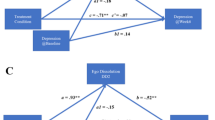Abstract
It is widely assumed that homeostatic control mechanisms regulate mood fluctuations whenever they deviate from a single set point. However, these mechanisms seem to be insufficient to explain the rich flexibility shown by the affective system. Much like the multistable physiological systems that operate on different time scales under allometric control, the affective system may show multistability. In this study, we looked for the signature of multistability, i.e. scaling, to test the hypothesis that mood and anxiety fluctuations are under allometric control, and we explored the associations between scaling and several emotion regulation strategies. Thirty-two undergraduate students reported mood and anxiety scores three times per day for a period of 50 days. Each time series was analyzed to obtain the scaling exponent h. In all cases .5 < h < 1, thus lending support to the main hypothesis of the study. Anxiety scaling exponents were associated with both positive reappraisal and refocusing strategies. Future research should focus on the association between the loss of multistability and socioemotional unflexibility.


Similar content being viewed by others
References
Bonsall, M. B., Wallace-Hadrill, S. M. A., Geddes, J. R., Goodwin, G. M., & Holmes, E. A. (2012). Non-linear time series approaches in characterising mood stability and mood instability in bipolar disorder. Proceedings of the Royal Society B: Biological Sciences, 279(1730), 916–924. doi:10.1098/rspb.2011.1246.
Burton, C., Knoop, H., Popovic, N., Sharpe, M., & Bleijenberg, G. (2009). Reduced complexity of activity patterns in patients with chronic fatigue syndrome: A case control study. BioPsychoSocial Medicine, 3, 7. doi:10.1186/1751-0759-3-7.
Chow, S., Ram, N., Boker, S. M., Fujita, F. & Clore, G. (2005). Emotion as a thermostat: representing emotion regulation using a damped oscillator model. Emotion, 5(2), 208–225.
Clark, L. A., & Watson, D. (1988). Mood and the mundane: Relations between daily life events and self-reported mood. Journal of Personality and Social Psychology, 54, 296–308. doi:10.1037//0022-3514.54.2.296.
Courvoisier, D. S., Eid, M., Lischetzke, T., & Schreiber, W. H. (2010). Psychometric properties of a computerized mobile phone method for assessing mood in daily life. Emotion, 10, 115–124. doi:10.1037/a0017813.
Delignières, D., Fortes, M., & Ninot, G. (2004). The fractal dynamics of self-esteem and physical self. Nonlinear Dynamics in Psychology and Life Science, 8, 479–510.
Garnefski, N., & Kraaij, V. (2007). The cognitive emotion regulation questionnaire—Psychometric features and prospective relationships with depression and anxiety in adults. European Journal of Psychological Assessment, 23, 141–149. doi:10.1027/1015-5759.23.3.141.
Garnefski, N., Kraaij, V., & Spinhoven, P. (2001). Negative life events, cognitive emotion regulation and emotional problems. Personality and Individual Differences, 30, 1311–1327. doi:10.1016/S0191-8869(00)00113-6.
Goldberger, A. L. (1996). Non-linear dynamics for clinicians: Chaos theory, fractals, and complexity at the bedside. Lancet, 347, 1312–1314. doi:10.1016/S0140-6736(96)90948-4.
Goldberger, A. L., & West, B. J. (1987). Applications of nonlinear dynamics to clinical cardiology. Annals of the New York Academy of Science, 504, 195–213. doi:10.1111/j.1749-6632.1987.tb48733.x.
Gottschalk, A., Bauer, M. S., & Whybrow, P. C. (1995). Evidence of chaotic mood variation in bipolar disorder. Archives of General Psychiatry, 52, 947–959.
Hollenstein, T., Lichtwarck-Aschoff, A., & Potworowski, G. (2013). A model of socioemotional flexibility at three time scales. Emotion Review, 5(4), 397–405. doi:10.1177/1754073913484181.
Kantz, H., & Schreiber, T. (1997). Nonlinear time series analysis. Cambridge: Cambridge University Press.
Kello, C. T., Brown, G. D. A., Ferrer-i-Cancho, R., Holden, J. G., Linkenkaer-Hansen, K., Rhodes, T., et al. (2010). Scaling laws in cognitive sciences. Cell Press: Trends in Cognitive Sciences, 14, 223–232. doi:10.1016/j.tics.2010.02.005.
Kim, S. (2005). Fractal structure of a white cauliflower. Journal of the Korean Physical Society, 46(2), 474–477.
Kuppens, P., Oravecz, Z., & Tuerlinckx, F. (2010). Feelings change: Accounting for individual differences in the temporal dynamics of affect. Journal of Personality and Social Psychology, 99, 1042–1060. doi:10.1037/a0020962.
Larsen, R. J. (1987). The stability of mood variability: A spectral analytic approach to daily mood assessments. Journal of Personality and Social Psychology, 52, 1195–1204. doi:10.1037//0022-3514.52.6.1195.
Mandelbrot, B. (1967). How long is the Coast of Britain? Statistical self-similarity and fractional dimension. Science, 156(3775), 636–638.
Nolen-Hoeksema, S. (2000). The role of rumination in depressive disorders and mixed anxiety/depressive symptoms. Journal of Abnormal Psychology, 109, 504–511. doi:10.1037/0021-843X.109.3.504.
Russell, J. A., & Carroll, J. M. (1999). On the bipolarity of positive and negative affect. Psychological Bulletin, 125, 3–30. doi:10.1037//0033-2909.125.1.3.
Schreiber, T., & Schmitz, A. (2000). Surrogate time series. Physica D: Nonlinear Phenomena, 142, 346–382.
Solomon, R. L. (1980). The opponent-process theory of acquired motivation: The costs of pleasure and the benefits of pain. American Psychologist, 35, 691–712. doi:10.1037/0003-066X.35.8.691.
Van Orden, G. (2007, February). The fractal picture of health and wellbeing. Psychological Science Agenda, 21. Retrieved from http://www.apa.org/science/about/psa/2007/02/van-ordern.aspx.
West, B. J. (1990). Fractal forms in physiology. International Journal of Modern Physics B, 4, 1629–1669. doi:10.1142/S0217979290000826.
West, B. J. (2006). Where medicine went wrong: Rediscovering the path to complexity. Hackensack: World Scientific.
West, B. J., Griffin, L. A., Frederick, H. J., & Moon, R. E. (2005). The independently fractal nature of respiration and heart rate during exercise under normobaric and hyperbaric conditions. Respiratory Physiology and Neurobiology, 145, 219–233. doi:10.1016/j.resp.2004.07.010.
Woyshville, M. J., Lackamp, J. M., Eisengart, J. A., & GillilandJ, A. M. (1999). On the meaning and measurement of affective instability: Clues from chaos theory. Biological Psychiatry, 45, 261–269. doi:10.1016/S0006-3223(98)00152-8.
Yeragani, V. K., Pohl, R., Mallavarapu, M., & Balon, R. (2003). Approximate entropy of symptoms of mood: An effective technique to quantify regularity of mood. Bipolar Disorders, 5, 279–286. doi:10.1034/j.1399-5618.2003.00012.x.
Acknowledgments
This research was supported by Grant PSI2009-12711 from the Spanish Government. The authors would like to thank Dr. Wolfgang Tschacher for his helpful comments on an earlier version of the mansucript, Dr. Jordi Llabrés for providing the online assessment tools and Dr. Miquel Noguera for his mathematical assistance.
Author information
Authors and Affiliations
Corresponding author
Rights and permissions
About this article
Cite this article
Bornas, X., Balle, M., Morillas-Romero, A. et al. Allometric control of daily mood and anxiety fluctuations. Motiv Emot 39, 571–579 (2015). https://doi.org/10.1007/s11031-015-9471-4
Published:
Issue Date:
DOI: https://doi.org/10.1007/s11031-015-9471-4




